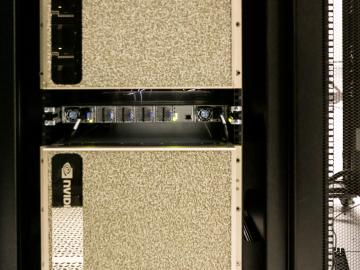Filter News
Area of Research
- (-) Materials (55)
- (-) National Security (5)
- (-) Supercomputing (31)
- Advanced Manufacturing (6)
- Biological Systems (1)
- Biology and Environment (4)
- Building Technologies (1)
- Clean Energy (60)
- Climate and Environmental Systems (2)
- Computational Engineering (1)
- Computer Science (8)
- Fusion Energy (6)
- Neutron Science (23)
- Nuclear Science and Technology (11)
- Quantum information Science (3)
- Transportation Systems (1)
News Topics
- 3-D Printing/Advanced Manufacturing (5)
- Advanced Reactors (2)
- Artificial Intelligence (7)
- Big Data (5)
- Bioenergy (3)
- Biomedical (2)
- Clean Water (2)
- Composites (1)
- Computer Science (25)
- Cybersecurity (3)
- Energy Storage (5)
- Environment (6)
- Exascale Computing (2)
- Frontier (2)
- Fusion (2)
- Grid (2)
- Isotopes (1)
- Machine Learning (1)
- Materials Science (18)
- Microscopy (5)
- Molten Salt (1)
- Nanotechnology (6)
- Neutron Science (5)
- Nuclear Energy (8)
- Physics (3)
- Polymers (2)
- Quantum Science (5)
- Security (2)
- Space Exploration (2)
- Summit (9)
- Sustainable Energy (6)
- Transportation (6)
Media Contacts

Oak Ridge National Laboratory scientists analyzed more than 50 years of data showing puzzlingly inconsistent trends about corrosion of structural alloys in molten salts and found one factor mattered most—salt purity.

OAK RIDGE, Tenn., Jan. 31, 2019—A new electron microscopy technique that detects the subtle changes in the weight of proteins at the nanoscale—while keeping the sample intact—could open a new pathway for deeper, more comprehensive studies of the basic building blocks of life.

As home to three top-ranked supercomputers of the last decade, the US Department of Energy’s (DOE’s) Oak Ridge National Laboratory (ORNL) has become synonymous with scientific computing at the largest scales. Getting the most out of these science machines, however, requires a w...

Jon Poplawsky, a materials scientist at the Department of Energy’s Oak Ridge National Laboratory, develops and links advanced characterization techniques that improve our ability to see and understand atomic-scale features of diverse materials

Scientists at Oak Ridge National Laboratory and Hypres, a digital superconductor company, have tested a novel cryogenic, or low-temperature, memory cell circuit design that may boost memory storage while using less energy in future exascale and quantum computing applications.

Oak Ridge National Laboratory scientists studying fuel cells as a potential alternative to internal combustion engines used sophisticated electron microscopy to investigate the benefits of replacing high-cost platinum with a lower cost, carbon-nitrogen-manganese-based catalyst.

By analyzing a pattern formed by the intersection of two beams of light, researchers can capture elusive details regarding the behavior of mysterious phenomena such as gravitational waves. Creating and precisely measuring these interference patterns would not be possible without instruments called interferometers.




